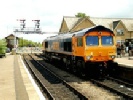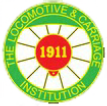By Dr M.C. Duffy
From the November 2006 Newsletter
In 1900 British influence, identified with plate frames and the use of inside cylinders, was strong but existed alongside distinct French, German and American traditions. Typical engines would weigh up to 100-120 tons and develop 1000 cylinder hp. In the 20th Century American designs and organisation of steam traction became global standards, due to research by universities, railroads and the engineering industry. Germany and Russia cultivated railway science based on late 19th Century studies of locomotive balancing, components failure, rail working. Methods for testing engines were pioneered by Babbage and Reynolds in Great Britain; Borodin and Lomonosov in Russia; and Le Chatelier in France. In the USA Goss and Lawford Fry analysed locomotive economics and discovered principles of 20th Century design. Their techniques were widely copied. Rational design methods spread slowly and obsolete traditions survived long. In Germany and the USA, large manufacturers spread modern practice via their products. In Russia and Germany, the state fostered railway research in technical universities modelled after the French Polytechnics. Germany and Russia used standard designs on state-controlled railways. In the USA, "war standard" rolling stock introduced modern practice. Few railways achieved near-complete standardisation using modem locomotives and obsolete types remained in service until steam traction ended. Great Britain was slow to use modern methods and economists warned of a national backwardness in railway engineering.
After 1900 North American designs departed radically in size, weight, tractive effort and power from the European. The basic "Stephenson" locomotive remained the norm throughout the 20th Century, improved by superheating, piston valves and the rational proportions pioneered by Goss and Woodard in the USA. Radical departures from this norm failed and were always rare. On general purpose railways outside rapid transit systems, there was no alternative to steam traction before the 1940s. The availability of cheap, disciplined labour was essential to effective operation and rising workforce costs after 1930 made better management of the traction system essential. Throughout the 20thCentury express passenger locomotives worked heavier trains at sustained speeds higher than in the period 1890-1910, but top speeds did not increase much apart from a few record runs over 100 mph of little practical significance and steam traction coped until the 1950s. In 1935 the world speed record for steam was set at 126 mph by the British 4-6-2 engine "Mallard". In the period 1900-1930 goods trains of 3000 -6000 tons were moved slowly (5-10 mph) and required engines with high tractive effort, low speed and moderate power. The compound-expansion Mallet type, weighing up to 350 tons, was employed in the USA for this duty. After 1930, operations favoured lighter, faster trains and the high-powered, high-speed, rigid-framed 2-8-4 or 2-10-4 type was widely used.
Woodard, Goss, et al. increased performance using the basic Stephenson type, demonstrated by engine No 50,000 of 1910. These principles were copied elsewhere. In Britain, the locomotives designed by Gresley after 1922 were derivatives of engine 50,000. Woodard's philosophy was applied to 4-6-2, 2-8-4, 2-10-4 and the later Mallet types and by 1930 the American steam locomotive had virtually reached its final form. Locomotives exported to Russia, Japan, and China established the American exemplar in those countries in the 1930s. Post-1945 types exported to Europe as part of the UNRRA programme established American practice more firmly than ever, including servicing and operating methods. High-powered designs reached finality in the S1 6-4-4-6 "Duplex" locomotive of 1939, built to sustain 6500 hp and speeds of 100 mph with 1000 tons on the level. Operated on the Pennsylvania RR, its great size (140 ft long), weight (482 US tons) and limited route availability suggested that conventional steam traction was approaching its limit, and that another mode of traction would be needed to raise power and speed standards after the 1940’s,
Steam traction reached practical perfection by integrating the locomotive with the track through better balancing technique; rationalising locomotive proportions, and applying scientific management to all parts of the traction system. This system worked best with simple, standardised locomotives with two outside cylinders and all components distributed for ease of maintenance. Mixed traffic locomotives were favoured able to work both passenger and goods trains. This was essential in the 1930's depression years, during the 1939-45 war and in the post-war period when labour was costly and funding scarce.
Locomotive science advanced after 1930. Fuel crises in the 1920's and the need for higher performance led to new forms of steam locomotive using innovations in power station technology and marine practice. These combined high pressure boilers, with turbines, vacuum condensers and electric transmission. Extremely complex machines were tried without success. Many projects were delayed by the 1939-45 war and revived afterwards, when diesel and electric traction were proven and affordable. In France, Chapelon developed a high performance locomotive, based closely on the orthodox form, which used compound expansion. Remarkable performances were demonstrated by Chapelon's 4-8-0, 4-6-2, 4-8-4, and 2-12-0 types between 1930 and the late 1940s. These were more promising designs than the contemporary high-pressure units developed by Muhlfeld in the USA, but they had no significance once post-war economies permitted use of diesel and electric traction.
In the 1940s and early 1950s the final efforts were made to develop a new form of steam locomotive free from the defects intrinsic to the orthodox type. The steam-electric locomotives of the C&O and N&W railways, tried between the late 1940s and early 1950s, were the last efforts in the USA. The N&W railway retained steam traction using well planned servicing stations, but the system became anachronistic and belated dieselisation proved essential in the 1960s. In the British Isles the unsuccessful experiments of Bulleid with locomotives with steam motors mounted in bogies concluded the search for a new form by the mid-1950s. Steam traction ended with the acceptance of the North American model, worked on the common-user system according to "Taylorist" principles of scientific management. Monthly "best milages" increased from c. 6000 miles in 1910 to 12,000 miles per month in 1939 for 4-6-4 locomotives on the high speed "Hiawatha" services, and 24,000 miles per month for 4-8-4 locomotives on New York Central express trains in the late 1940s. The need for increased speeds and productivity, in an age of motor transport, cheap air services and increasing labour costs, accelerated the shift to diesel and electric traction. Steam traction was intrinsically obsolete, and ail attempts to save it failed. One-man operations; automatic boiler regulation; multiple-unit working; electric transmission were tried and failed. The "new forms" were unsuccessful, and the "old forms" were destructive of the track at high speeds - as the C&NW rail working tests had shown as early as the 1930s.
In its final form the American exemplar set the world standard. Typical weights for a North American 4-8-4 in running order were: Engine 480, 000-510,000 Ibs; Tender 360,000-460,000 Ibs, Length 110-122 feet. Sustained cylinder power was 5500-6000 hp, with maxima C7000 hp. The largest articulated locomotives (e.g. Union Pacific 4-8-8-4 class) weighed Engine 722,250 Ibs; Tender 436,500 Ibs; Length 132 feet. A modern steam locomotive would have most of the following features: a cast-steel bed; a welded boiler and steel firebox; rocking grate; self-cleaning smokebox; regulator valves in superheater header; compensated springing; mechanical lubrication; anti-distortion disk wheels; roller bearings on all axles; roller bearings in rods and motion; and modern front end. Some engineers would add a combustion chamber; syphons and circulators; and Franklin wedges in the driving axle boxes. Most American engines would have a stoker, unless they were oil-burning; power reverse gear, and two outside cylinders. The final types built later in Europe, Russia and China were derived from this American exemplar of the 1940s, but were much smaller. The French SNCF 242A1 3-cylinder compound 4-8-4 weighed Engine 326,283 Ibs; Tender 167,728, Length 87 feet. Maximum cylinder power was 5,400 hp. A typical British express 4-6-2 engine (Class A1) weighed Engine 235,648 Ibs; Tender 136,416 Ibs. Length 72 feet. Cylinder powers were of order 2500 hp maximum. Improvements to the steam locomotive were applied in backward economies with cheap labour down to the 1990s. The work of Wardale in South Africa and Porta in South America provide examples. Other improvements, like the Giesel ejector invented in the late 1940s in Austria, enabled older engines to run more economically in the years left before scrapping. Recent improvements incorporated in new steam locomotives built in the 1990s for tourist railways do not change the status of steam traction. The fuel crises of the 1970s and after led to plans for coal-fired locomotives, which included triple-unit steam-electric machines with condensing tenders, but none was constructed and the coal-fired diesel electric and the coal-fired gas-turbine are favoured instead. The schemes for atomic powered steam-electric locomotives, proposed in the late 1940s and 1950s were never taken seriously by railwaymen.



